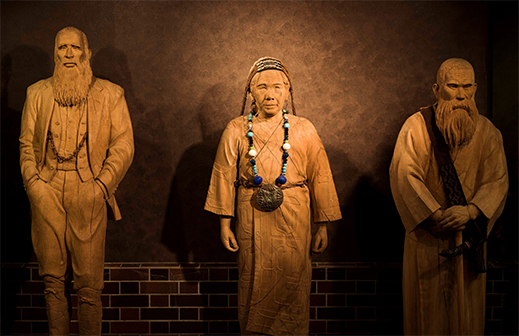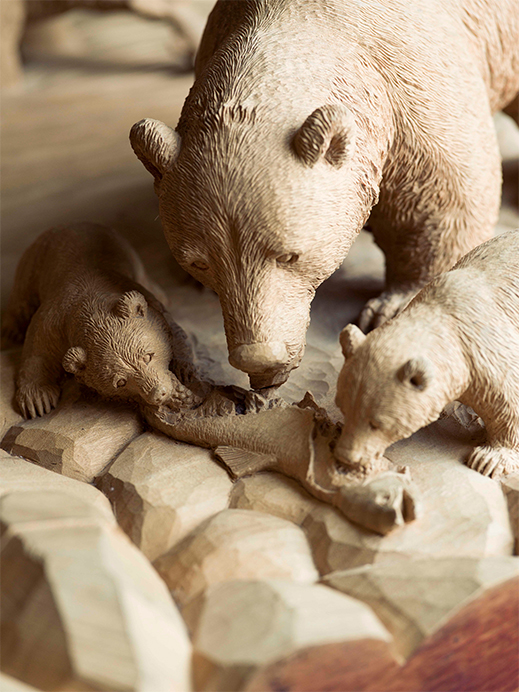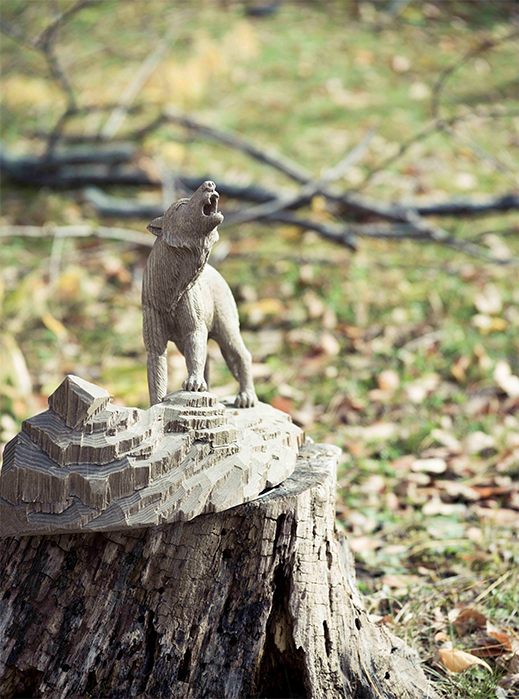 |
 |
 |
HOME > FOCUS > Currents, Full Circles, and the Calling of Ainu Woodcarver Fujito Takeki |
 |
 |
Focus features two in-depth reviews each month of fine art, architecture, and design exhibitions at art museums, galleries, and alternative spaces around Japan. |
|
|
 |
 |
 |
Currents, Full Circles, and the Calling of Ainu Woodcarver Fujito Takeki
Susan Rogers Chikuba |
 |
Located just outside the north exit ticket gate in the station's iconic 1914 Marunouchi building, Tokyo Station Gallery has offered a freewheeling mix of all arts from the fine to the industrial for three decades. Photo by Andi Winata |
The full moon in August 2021 falls on what would have been the 87th birthday of wood sculptor Takeki Fujito (1934-2018). I'll be marking the occasion with a visit to Tokyo Station Gallery, where the artist's first show in the Kanto area is itself a kind of fulfillment, another ripening of a career that spanned seven decades from when he first started carving as a young boy. Though they are largely unknown outside of Hokkaido, Fujito's snapshot-real sculptures of bears, other animals, and his own ancestors brim with an energy it's hard to forget once encountered. Ainu Woodcarver Fujito Takeki: Envoy of the Forest presents 82 of them, from his 1964 Angry Bear, which introduced a new, emotive style to the bear-carving genre, to Ambling Bear, a precious unfinished piece that is the last to have been shaped by his hands.
 |
|
Hikawa Zenjiro, 1991; Sugimura Fusa, 1993; Kawakami Konusa, 1993; private collection. These life-sized statues of Ainu elders were among several of Fujito's works shown at the Smithsonian Institution's 1999-2000 exhibition Ainu: Spirit of a Northern People. That catalog's section entitled "Ainu Fine Art Begins" leads with Fujito. |
Fujito made no preliminary sketches or prototypes. When, in 1968, he travelled to Kyoto and Nara to study Buddhist statuary in preparation for a professional commission, he brought no camera. He took no notes, either, as he had never learned to write. When carving he worked directly from his three-dimensional vision of each piece, exercising his extraordinary visuospatial skills through a craftsman's finely honed sense of the material and what it holds. He explained his artistic process as a kind of interplay, drawing out images from the wood by mirroring them back. It could be that his talent for shaping ideas into forms, and his photographic memory, too, were amplified by the fact that his artist's eye was unfettered, or never conditioned, by the linear constraints of script.
Bears Attack Buck, 1977, private collection |
To fully appreciate Fujito's works, it's helpful to keep in mind that most of them are hewn from a single block of wood as is -- no joinery, no attachments. (Exceptions are his marine series, particularly crabs that he fashioned with intricate moving parts, and some human figures that carry accessories, tools, or weapons.) The bear leaping from a tree to attack a buck; the rambunctious polar-bear cubs at their mother's feet, peering into the sea from an ice floe; the six bears hunting at a salmon run -- all elements of these sculpted dramas are of a piece with the base on which they rest. In some cases, even, there is no base. Bears at Play (1977), for example, is a study in balance -- three animals in a tussle, one body part supporting another.
|
 |
|
|
|
White-Tailed Eagle, 1978, private collection. Fujito seldom carved birds, and we can only puzzle why. The roughly hewn ground of this work, evocative of highland scree, also serves to set off, by contrast, the exquisite detailing of the raptor's plumage and the intensity of its gaze.
|
In Taking Down a Buck (1978), two wolves ambush a deer, one already with a death-hold on the stag's neck as the other lunges in for the kill, fangs bared. The latter wolf's hind legs, like those of its panicked prey, are not even touching the ground. Other than the stop-action drama, what's striking is the precision with which Fujito shapes and weights his figures. The illusion is that the buck is supported only by its two slender forelegs as it kicks high, but in fact the mass of the first wolf, clenched onto the deer's jowl, is what secures it firmly to the carving's base. Imagine Fujito working from a solid log, calculating such forms and the spaces between them as he chisels away the excess wood. And then there is the fine detailing -- the grooves of an antler, a tapered claw, the nap of fur, some rippling muscle. In White-Tailed Eagle he shows us the imprint of talons on the hare's flesh: we are meant to know that this is the split second when the eagle has just lit onto its prey and is clamping down before taking flight. In Spring Shedding, Fujito opens up the tiniest fraction of space between the ground and the natural curvature of a dropped antler. The goal, he often said, is to carve even the places that cannot be seen.
 |
|
Whole-Body Listening (detail), 2002, collection of Tsuruga Resort Co., Ltd. When it came to exacting detail in the bear-carving genre, Fujito was in a league all his own. And where his predecessors focused on physical postures, he brought a subtle, emotive quality to his works. |
Also featured in the show are 13 vintage bears, some whose dates and carvers are unknown, that were part of Fujito's private collection. The prewar years of the 1930s and the postwar boom years from the 1950s to the 1970s were peak periods of Hokkaido tourism. Wooden bears, once prominently displayed in homes across Japan, are tokens of those times. How is it that the Ainu, for whom bears are a key deity, came to produce them as souvenirs? The answer, in a word, is colonialism, and on this topic Fujito cites two independent currents that later merged.
Antique bears on display, collected by Fujito, include some that date back to the first decades of the 1900s. Photo by Susan Rogers Chikuba |
First, the Ainu of the Chikabumi (Cikapuni) settlement in Asahikawa had for centuries been carving bear heads onto ceremonial libation sticks and headgear -- Fujito himself inherited such items, handed down from his great-grandfather Konusa Kawakami (1860-1942; pictured above). As the colonization of Hokkaido intensified from the 1880s on, Asahikawa was a key defense center of the Imperial Japanese Army and in 1901 became its central garrison on the island. Amid the harsh sanctions of the times, the Ainu here began to produce stand-alone bears from around the 1920s, to sell as a means of survival. Collectors' items today, these early, less finessed examples of the genre came to be known as "crocodile" and "pig" bears because of their simple features. Meanwhile, some 200 miles away on the Oshima Peninsula, the Owari branch of the Tokugawa family had been engaged in converting Ainu lands into farms by settling former samurai from the Nagoya area in Yakumo (Yurappu). These conscript farmers were struggling, too, and in 1923 Yoshichika Tokugawa, inspired by the Black Forest carvings he had brought back from Switzerland, suggested they use the long winter months to craft wooden bears as a cottage industry. These two currents met, and, not to be outdone where bears were concerned, the Asahikawa Ainu -- naturally the keener observers of Hokkaido's brown bears and their ways -- soon took to carving them in different poses, with realistic features. Fujito's father, who had begun carving around 1925 at the age of 16, was among these early craftsmen.
|
 |
|
|
|
River's Bounty (detail), 2000, collection of Tsuruga Resort Co., Ltd.
|
Parenting and family are common themes for Fujito, who lost his mother in infancy and spent his childhood by turns with an attentive grandmother and an often absent and abusive father. River's Bounty, one of his larger carvings, depicts the rushing waters of a salmon run. Among the adult bears hunting at this cascade is one with two cubs, who dig in with gusto to the meal provided. In Mother and Child (2004), a bear listens patiently to her wailing cub. Mother Wolf and Pups is a title Fujito worked twice, in Japanese walnut in 1978 and in bog ash in 2000. His sometimes humorous, sometimes tender takes on relationship can also be seen in works like Courtship (1998), Polar Bears: He & She (1999), and the truly poignant Bear Talk (2018). An intimate tribute to his wife, Shigeko, this last one he carved in April, just days after confiding to her how he'd like his funeral to be arranged. Fujito passed away half a year later and must have known that the time was near.
 |
|
Bear Talk, 2018, private collection |
The last work Fujito completed, sometime in May or June of 2018, was Gray Wolf Howls. His concern for the Hokkaido gray wolf ran deep, a background I addressed in this review of an earlier retrospective in 2017. Fujito's family notes that he engraved this carving, oddly, with the date of his own August birthday, still some months ahead. When that day came, he had already been hospitalized. It's as though, knowing he would soon no longer be able to wield a blade, he had dedicated this last piece to mark the occasion. As I write these words, fond memories of the first time I met Fujito and his wife, four years ago to the day, swirl in my mind. I appreciate such circular gifts and look forward to meeting his artist's spirit again in Tokyo amid his many endearing creations, as a full moon rises on the start of an auspicious 88th year.
|
 |
|
|
|
Gray Wolf Howls, 2018, private collection
|
Admission to the exhibition is by advance reservation through the ticketing service at Lawson convenience stores. The codes are 36118 for August and 36119 for September. A limited number of same-day tickets may be on offer at the museum each day, depending on availability. For those who would prefer to see the works online, an interview with Shigeko Fujito and a walk-through of the exhibits by Tokyo Station Gallery director Akira Tomita will be held in Japanese via Zoom on 17 August from 2 to 3:30 p.m. Coordinated by Halmek magazine, the event costs ¥1,000 and bookings must be made no later than 12 August.
Polar Bear and Cubs (detail), 1999, private collection |
Disclaimer! I had the pleasure of translating the catalog and exhibit texts for this show. All photo permissions are courtesy of Tokyo Station Gallery.
|
 |
 |
Susan Rogers Chikuba
Susan Rogers Chikuba, a Tokyo-based writer, editor and translator, has been following popular culture, architecture and design in Japan for three decades. She covers the country's travel, art, literary and culinary scenes for domestic and international publications. |
|
 |
|
|
 |
|
 |
|